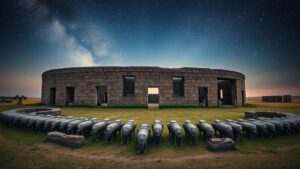Searching for Itzamkanac, the ancient capital of the Itza people in Central America.
Searching for Itzamkanac: The Ancient Capital of the Itza People
The Itza people, a Maya civilization known for their profound understanding of astronomy, agriculture, and architecture, established Itzamkanac as their capital in the region that is now part of modern-day Guatemala. This article delves into the history, significance, and recent efforts to locate this ancient city that thrived during the Late Postclassic period (approximately 1200-1500 AD).
The Historical Context of Itzamkanac
Itzamkanac, believed to be situated near Lake Petén Itzá, served as a cultural and political hub for the Itza people, who were one of the last major Maya groups to endure after the Spanish conquest in the 16th century. The name Itzamkanac translates to House of Itzam, referring to the Maya god of wisdom, which reflects the citys significant religious and cultural role.
The city itself was characterized by its impressive architecture, reflecting the advanced engineering skills of its inhabitants. Structures made from limestone featured intricate carvings and were aligned with celestial bodies, showcasing the Itzas deep relationship with their environment.
Archaeological Evidence and Research
Despite Itzamkanacs historical importance, its exact location remains uncertain. Archaeologists have utilized various methods to identify potential sites through satellite imagery, LiDAR (Light Detection and Ranging), and ground-penetrating radar. In 2018, a team led by archaeologist Dr. Thomas Garrison discovered extensive ruins in the vicinity of the northern Petén region, which were speculated to be part of Itzamkanac.
Recent excavations at sites like Nakúm, seen as a sister city to Itzamkanac, provided artifacts such as pottery and stone tools, dating back to the period of the Itza. These findings suggest a complex urban system and trade networks that were foundational to Itzamkanacs economy and governance.
The Cultural Significance of Itzamkanac
Itzamkanac played a crucial role in the cultural evolution of the Itza people. The city not only served as a political center but also a place of worship, with temples dedicated to various deities and ceremonial practices. Itza also preserved Maya traditions, resisting European influences longer than most other Maya groups.
For example, the Itza maintained their language and cultural practices, which have been reflected in their traditional agricultural methods and ceremonial rituals that continue today. This has contributed to a rich cultural heritage that attracts researchers and visitors interested in indigenous studies and anthropology.
Modern Efforts to Rediscover Itzamkanac
Today, the quest for Itzamkanac has ignited the interest of both archaeologists and tourists alike. Various initiatives are underway to tap into the rich history of the Itza civilization through sustainable tourism and educational programs. Guatemalan government has also invested in preserving archaeological sites to promote cultural heritage.
Technological advancements have made it easier to visualize ancient structures and understand their layout within the landscape. The collaboration between local communities and researchers is essential in preserving this heritage while providing economic opportunities through eco-tourism.
Challenges and Considerations
While progress made, challenges remain in the search for Itzamkanac. Deforestation, illegal excavations, and climate change threaten the preservation of archaeological sites. Also, the complexities of land ownership and community rights must be respected as research and conservation efforts proceed.
- Deforestation and environmental degradation impact archaeological integrity.
- Illegal excavations contribute to the loss of invaluable artifacts.
- Collaboration with local communities is vital for sustainable research.
Actionable Takeaways
For those interested in exploring the cultural legacy of the Itza people and the search for Itzamkanac, consider the following:
- Participate in tours that emphasize sustainable tourism and cultural education.
- Support local initiatives aimed at preserving indigenous practices and sites.
- Stay informed about archaeological findings and their implications for understanding Maya history.
As the search for Itzamkanac continues, the rich history of the Itza people, coupled with modern technology and community involvement, promises to unveil more about this remarkable civilization and their enduring legacy in Central America.


